- Details
- Hits: 8547
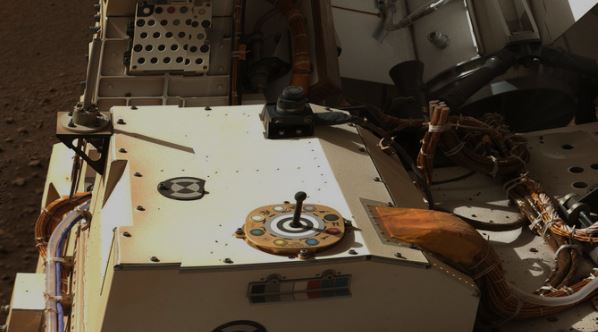 Everyone is excited about the landing of Perseverance, the Mars rover. If you look closely at the first panorama of the Martian landscape you will see on the equipment bay of Perseverance the Mastcam color calibration target. It sort of looks like it could be a sundial. In 2004 a similar calibration target was used as the first Martian sundial, designed by Dr. Woody Sullivan and Jim Bell with the support of The Planetary Society and Bill Nye, "The Science Guy" [See PDF at bottom]. Is the Mastcam color calibration target a sundial as well? Here is Dr. Sullivan's answer to a group of sundial enthusiasts (2/25/2021):
Everyone is excited about the landing of Perseverance, the Mars rover. If you look closely at the first panorama of the Martian landscape you will see on the equipment bay of Perseverance the Mastcam color calibration target. It sort of looks like it could be a sundial. In 2004 a similar calibration target was used as the first Martian sundial, designed by Dr. Woody Sullivan and Jim Bell with the support of The Planetary Society and Bill Nye, "The Science Guy" [See PDF at bottom]. Is the Mastcam color calibration target a sundial as well? Here is Dr. Sullivan's answer to a group of sundial enthusiasts (2/25/2021):
"The short answer is “No”. The longer answer follows. The new object on Perseverance (officially the "photometry calibration target") has obvious similarities to the Mars dials on Spirit and Opportunity that landed in 2004, and in fact it is a technological and aesthetic “grand-daughter” 17 years later. (The intervening generation is the Curiosity rover, which landed in 2013 and is still alive). The Mars dials that a small group of us designed and fabricated and then occasionally “used” to read Martian time were a great experience for me.
"But after over a decade of Spirit and Opportunity, I decided not to get involved in any future NASA missions — they gobble up a lot of time! The science and fabrication of the new calibration target (as for Curiosity) is led by a group at U. of Copenhagen.
"Nobody has ever done anything with the orientation of the shadows cast by the “gnomon” on Curiosity and I’m sure nobody will for Perseverance either. By the way, independent of gnomonics, the vertical tube has a vital scientific purpose: its shadow on the gray and colored patches allows one to calibrate camera images properly in shadow as well as sunlight.
"The various symbolism and messages on Perseverance also stem directly as heritage from Spirit and Opportunity . You can find a tremendous amount of detail about all aspects of the Perseverance cal target (including construction) at https://mastcamz.asu.edu/mars-in-full-color/ [See PDF at bottom]. The feature I like best is the motto “Two Worlds, One Beginning”, which nicely refers to Spirit and Opportunity ’s “Two Worlds, One Sun” as well as early solar system history and the possibility of early life on Mars. (Curiosity has the terrible motto “To Mars to Explore”.)
"Nevertheless, I watch the procession of missions with great astrobiology interest. And someday I will write up the whole Mars dial experience, including many Martian landscape images in which it appears, and how a student and I were actually able, using its shadow, to measure the Martian analemma at local mean (“clock”) noon over a Martian year ( = 1.9 Earth years).
— Woody Sullivan
Prof. (Emeritus) Woodruff T. Sullivan, III
Dept. of Astronomy & Astrobiology Program Box 351580
University of Washington
Seattle, WA 98195 USA
- Details
- Hits: 16334
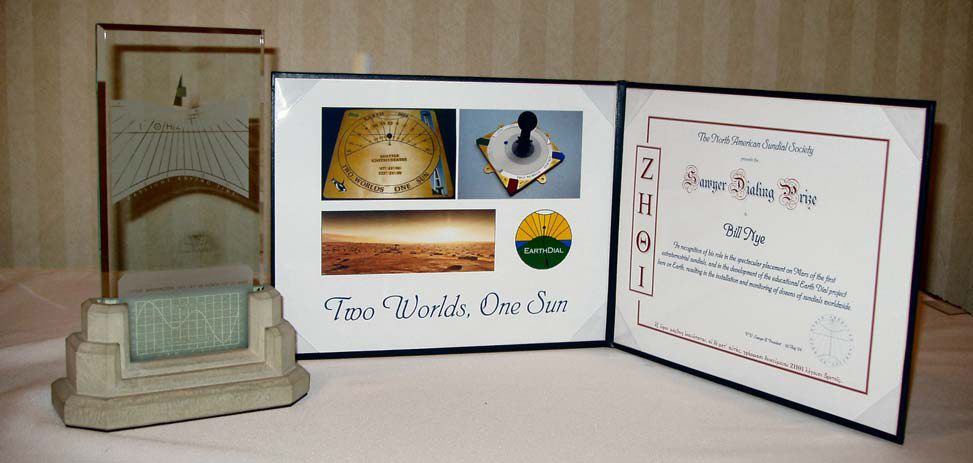 At the 2004 NASS Conference in Tenafly, NJ, Fred Sawyer announced that the Sawyer Dialing Prize would go jointly to Bill Nye and Woodruff (Woody) Sullivan for their efforts to transform the Mars Rover Pancam calibration disk into a Martian sundial (with electronically placed hour lines) that could be viewed on the Internet. The award was a foregone conclusion at the inception of the prize some years ago, but awaited the success of the Mars Rover landings in 2004. [Photo Credit: NASA/JPL/Cornell] http://athena.cornell.edu/kids/sundial.html
At the 2004 NASS Conference in Tenafly, NJ, Fred Sawyer announced that the Sawyer Dialing Prize would go jointly to Bill Nye and Woodruff (Woody) Sullivan for their efforts to transform the Mars Rover Pancam calibration disk into a Martian sundial (with electronically placed hour lines) that could be viewed on the Internet. The award was a foregone conclusion at the inception of the prize some years ago, but awaited the success of the Mars Rover landings in 2004. [Photo Credit: NASA/JPL/Cornell] http://athena.cornell.edu/kids/sundial.html
Unfortunately neither Bill nor Woody was able to attend the conference, but a descriptive paper by Bill was read explaining the corresponding Earth Dial project (“Two Worlds, One Sun”), showing similar styled dials in Utah, Honduras, Ohio, Virginia, Chile, Canada, the UK, Spain, and even the South Pole. Download the PDF created by Nye Labs at revealing how to make a replica of the Mars Dial.
- Details
- Hits: 14530
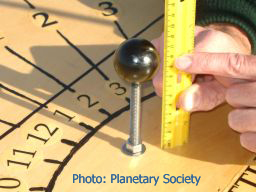 The Planetary Society and Bill Nye, The Science Guy, are bringing back the Earth Dial, which is a simple to make gnomonic horizontal sundial reminiscent of the sundial incorporated into the Mars rovers Spirit, Opportunity and now Curiosity. Their original and fundamental purpose is to serve as test patterns for the rover cameras, but they also provide an opportunity as unique shadow casting sundials.
The Planetary Society and Bill Nye, The Science Guy, are bringing back the Earth Dial, which is a simple to make gnomonic horizontal sundial reminiscent of the sundial incorporated into the Mars rovers Spirit, Opportunity and now Curiosity. Their original and fundamental purpose is to serve as test patterns for the rover cameras, but they also provide an opportunity as unique shadow casting sundials.
“Since we had shadows being cast on Mars, I suggested it be a sundial… I admit I was quite enthusiastic about it. Steve Squyres, the Principle Investigator on the Spirit and Opportunity missions, made the call, and the Mars Dials were created. He received the [Planetary] Society’s Cosmos medal a few years ago, for his wonderful leadership of the project.”
The Earth Dial project was started in 2004 and now, nearly a decade later, is being brought back. Visit the Planetary Society website Planetary Society - Earth Dial for details and download the attachment below to construct your own Earth Dial.
- Details
- Hits: 17103
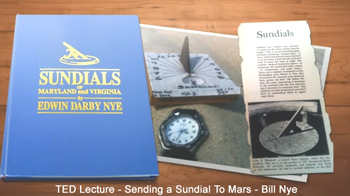 Bill Nye, The Science Guy gives a 7 minute TED-ED talk describing the excitement of creating sundials on Mars. http://ed.ted.com/lessons/sending-a-sundial-to-mars-bill-nye
Bill Nye, The Science Guy gives a 7 minute TED-ED talk describing the excitement of creating sundials on Mars. http://ed.ted.com/lessons/sending-a-sundial-to-mars-bill-nye
TED stands for Technology, Entertainment, and Design, a nonprofit organization devoted to spreading ideas of worth. Conferences are held each year with more than 50 guest speakers to motivate the audience on many different fields and now through YouTube, you can share the excitement of sundialing.
- Details
- Hits: 15660
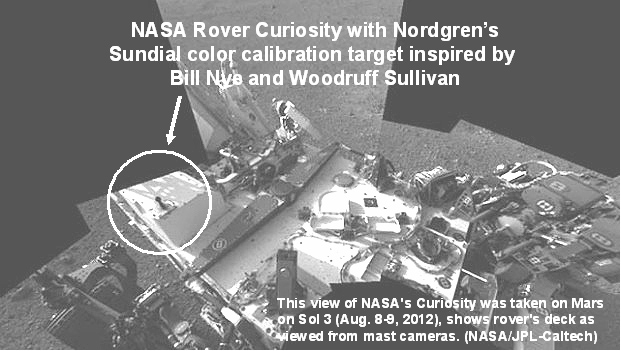 With the successful landing of the NASA rover Curiosity, another sundial is on planet Mars. Turning the color calibration target into a sundial was the idea of Bill Nye, the Science Guy, and Professor Woodruff Sullivan at the University of Washington, originally hailed by “Two Worlds – One Sun”
With the successful landing of the NASA rover Curiosity, another sundial is on planet Mars. Turning the color calibration target into a sundial was the idea of Bill Nye, the Science Guy, and Professor Woodruff Sullivan at the University of Washington, originally hailed by “Two Worlds – One Sun”
THese two sundial enthusiasits have been encouraging people around the world to make their own sundials and collectively participate using webcams to tell solar time around the earth. See: http://sundials.org/index.php/features/168-curiosity-sundial-launched and read the details of the sundial with the following PDF download: MarsDialReport.pdf
Curiosity’s calibration target was created by Tyler Nordgren at the University of Redlands. However Nordgren and a group of six scientists, astronomers, educators, and artists (including Nye and Sullivan) went further. Said Nordgren, "But we thought, why not use this very dry boring technical piece of equipment, and turn it into something beautiful and evocative?"
The calibration target turned sundial is actually a leftover from NASA’s Mars Exploration Rover (MER) Spirit. Along the edges of the sundial MARS is written out in 16 different languages. The sundial’s center represents the sun with a concentric grey ring for the earth’s nearly circular orbit and a displaced white ring for Mars eccentric orbit. The positions of Earth and Mars, shown respectively by a blue and red dot are placed for the date of impact at 10:32 pm Aug 5th PDT. Every MARS sundial has a date and motto. “It's sundial tradition,” says Nordgren. Curiosity says "MARS 2012" and "TO MARS TO EXPLORE."
Each home-plate color slice has a phrase describing what the mission means for human exploration. It reads:
“For millennia, Mars has stimulated our imaginations. First we saw Mars as a wandering red star, a bringer of war from the abode of the gods. In recent centuries, the planet's changing appearance in telescopes caused us to think that Mars had a climate like the Earth's. Our first space age views revealed only a cratered, Moon-like world, but later missions showed that Mars once had abundant liquid water. Through it all, we have wondered: Has there been life on Mars? To those taking the next steps to find out, we wish a safe journey and the joy of discovery."
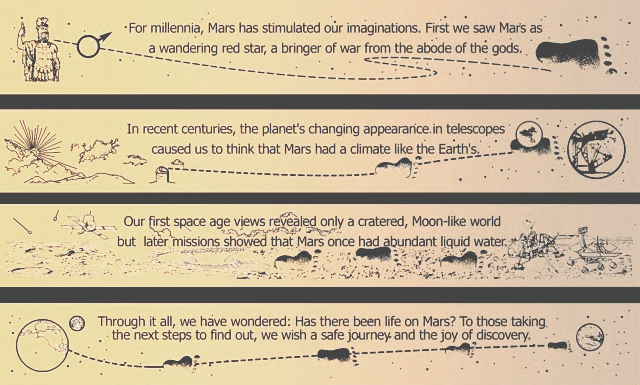
Dr. Woody Sullivan discussed the history of the Mars Dials on a recent Sundial Digest forum (11 Aug 2012, Vol. 80, Issue 8) https://lists.uni-koeln.de/mailman/listinfo/sundial
“[Above] is the first image of the latest "Mars Dial", which indeed is the calibration device for the main camera ("Mastcam") on Curiosity Rover, which landed safely in Gale Crater on Mars 5 days ago (hurrah!)."
"The Mars Dials were originally fabricated in 1999 for the Mars Rovers Spirit and Opportunity, which landed in 2004, and the latter of which is STILL working over 8 years later. To date over 35,000 images have been taken of the two Mars Dials - the most photographed thing on Mars! As mentioned below, I was intimately involved in all aspects of making these calibration devices into working sundials - design, fabrication, operations, etc. However, because of other commitments I chose not to be part of any Curiosity efforts, so my report in the following paragraph is that of a (very) interested observer."
"In order to save some money, the Curiosity Mars Dial is a slight modification of one of the 6 copies that we made in 1999. A couple of magnets were added (to try to repel dust), new plates were put on it to change various wording such as the date and, in particular, the motto. The motto is now "To Mars To Explore" rather than the previous "Two Worlds One Sun". But the biggest difference is that, as far as I know, no one is ever going to superimpose the hour/date lines so that it can actually be used as a sundial! And yet NASA's publicity continues to call it a sundial.....But I'm still very happy to see the first images of it….”
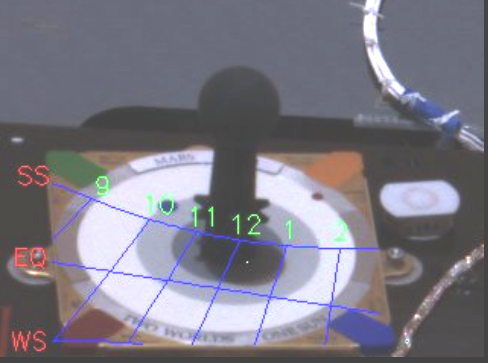
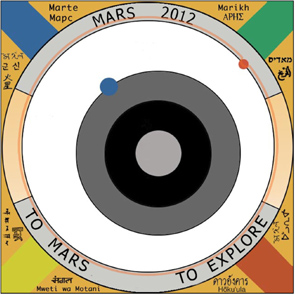 The image here is from the Mars Exploration Rover Spirit (look carefully for the motto “Two Worlds One Sun”) and according to a NASA news release, “was processed by students in the Red Rover Goes to Mars program to impose hour markings on the face of the dial. The position of the shadow of the sundial's post within the markings indicates the time of day and the season, which in this image is 12:17 p.m. local solar time, late summer. A team of 16 students from 12 countries were selected by the Planetary Society to participate in this program. This image was taken on Mars by the rover's panoramic camera.” [Image was produced at Cornell University - Image Nr: PIA05017]
The image here is from the Mars Exploration Rover Spirit (look carefully for the motto “Two Worlds One Sun”) and according to a NASA news release, “was processed by students in the Red Rover Goes to Mars program to impose hour markings on the face of the dial. The position of the shadow of the sundial's post within the markings indicates the time of day and the season, which in this image is 12:17 p.m. local solar time, late summer. A team of 16 students from 12 countries were selected by the Planetary Society to participate in this program. This image was taken on Mars by the rover's panoramic camera.” [Image was produced at Cornell University - Image Nr: PIA05017]
For more details of the Curiosity sundial, read an interview with Tyler Nordgren: http://www.popsci.com/science/article/2012-08/mars-rover-curiosity and http://wtvr.com/2012/08/03/nasa-mars-rover-curiosity-will-land-early-monday/
Read more about Curiosity’s instruments at http://www.nasa.gov/mission_pages/mars/main/index.html
- Details
- Hits: 15016
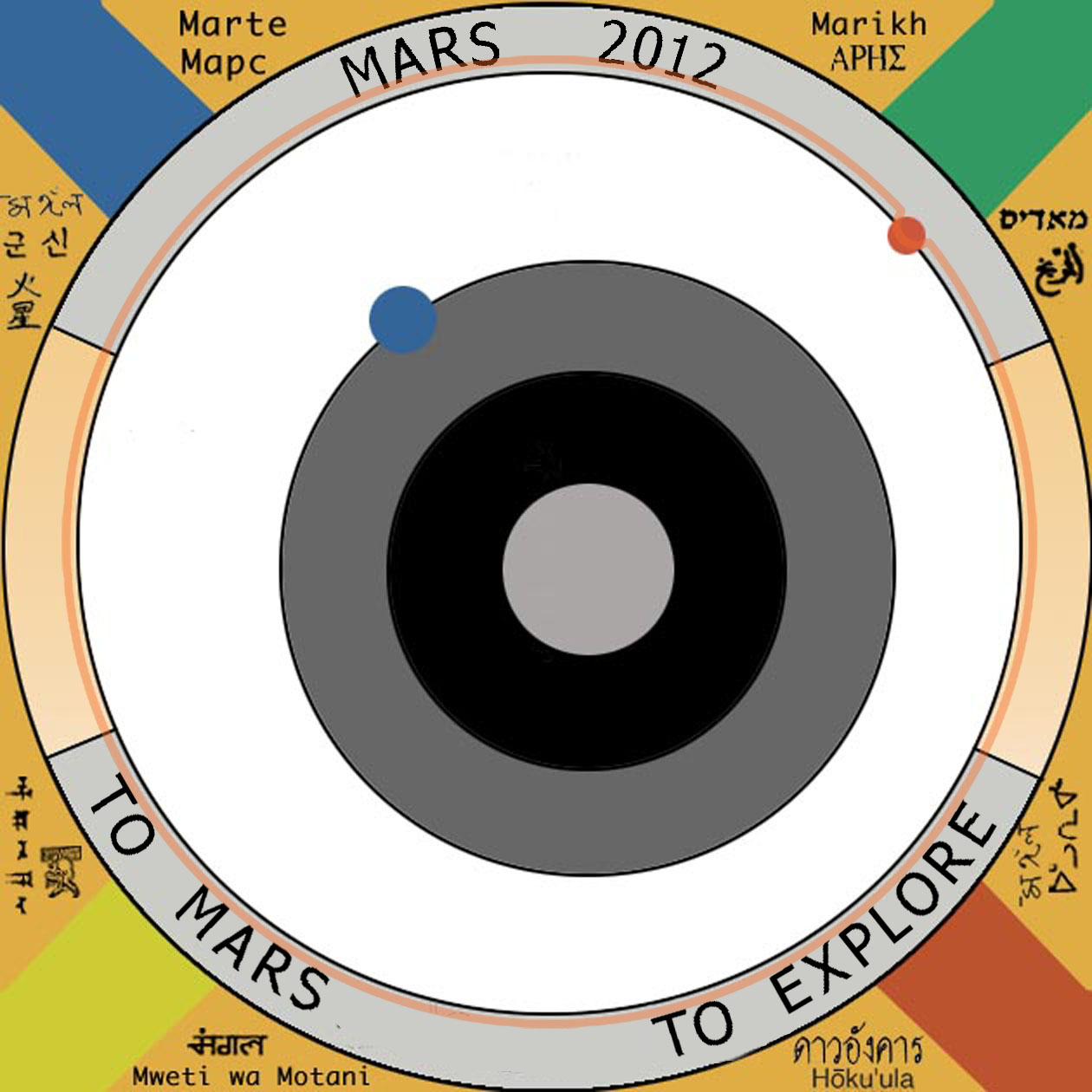 [photo courtesy of NASA]
|
The spacecraft was launched toward Mars on 26 Nov 2011. Onboard Curiosity the camera calibration sundial has four edges each containing a panel of text and image, written by Jim Bell, planetary scientist from Arizona State University and the Mars Exploration Rover team with graphics designed by artist Jon Lomberg.
The digital camera and calibration target was created by Tyler Nordgren from the University of Redlands and a group of six scientists, astronomers, educators and artists worked together to create a digital camera that is calibrated to photograph the climate on Mars. On the team was Bill Nye and Professor Sullivan.
Dr. Bell now executive Director of the Planetary Society and Lomberg were both on the team that designed the similar sundials for the the Spirit and Opportunity Martian rovers. Artist Jon Lomberg has a long history in spacecraft graphics, starting with Design Director for NASA’s Voyager Golden Record and a long-time collaborator of Carl Sagan. He won an Emmy Award for his work as Chief Artist of the TV series COSMOS. Read more at http://www.redlandsdailyfacts.com/news/ci_19476230 and http://citizenofthegalaxy.com/wordpress/?p=169
